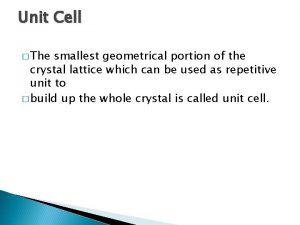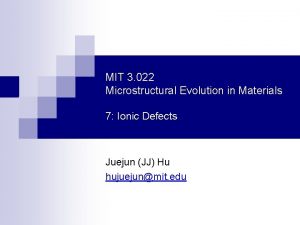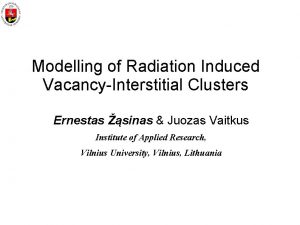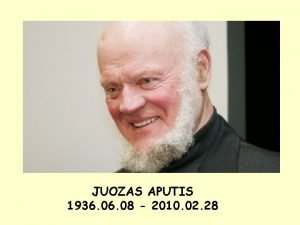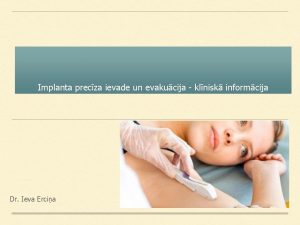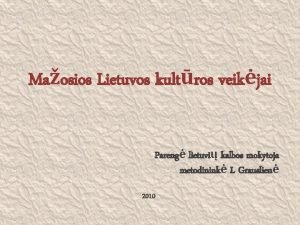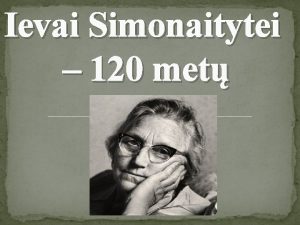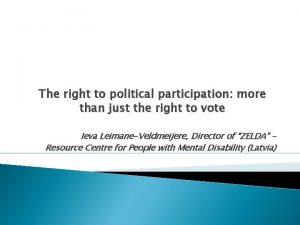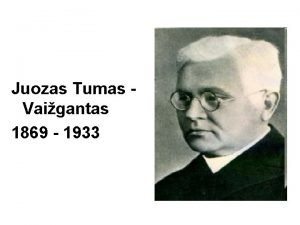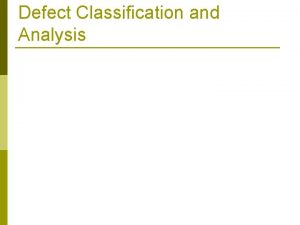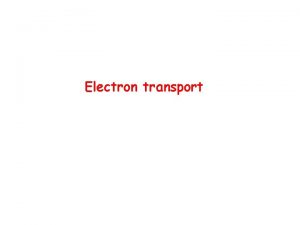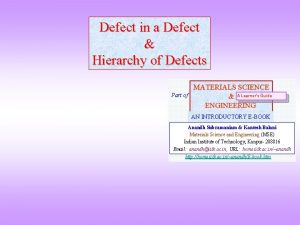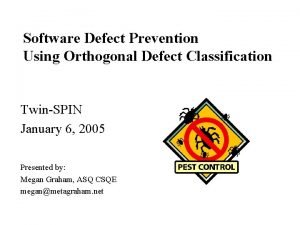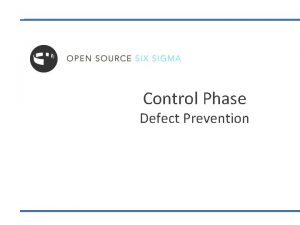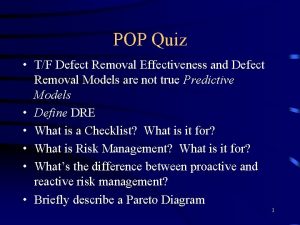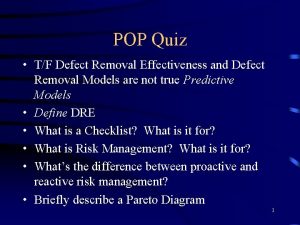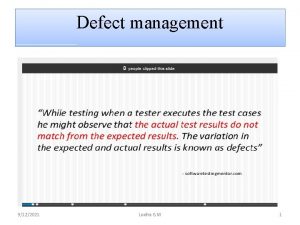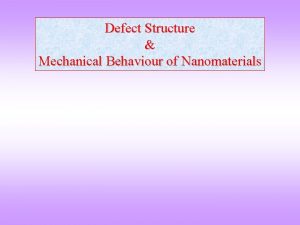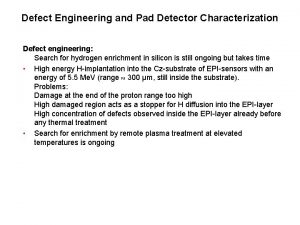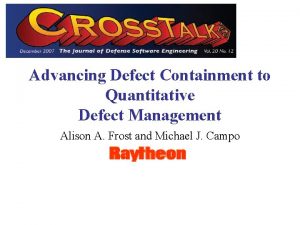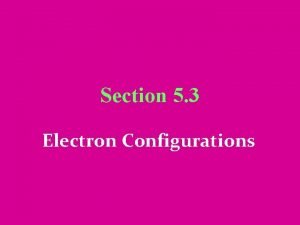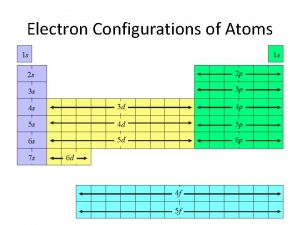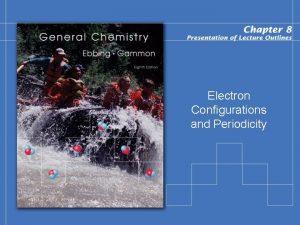Electron transport via defect network Ieva Guigait Juozas
























- Slides: 24

Electron transport via defect network Ieva Guigaitė Juozas Vaitkus Darius Abramavičius

Motivation 1. Irradiation by high energy particles induced defect network 2. Electron lifetimes are sensitive to geometry 3. Defects form nano-size clusters 4. Bulk theory is not sufficient 24 th RD 50 workshop, Bucharest

High Energy Particle (HEP) destroys the lattice: Interstitialrich region Disordered region H EP Vacancy-rich region TRIM and TCAS simulation results, presented by G. Lindstroem, 24 th RD 50 workshop, Bucharest, 2014. After relaxation of cascade deffect and recombination of I-V pairs the rest of the vacancies and interstitials remain separated in space.

Percolation network p=0. 25 • Classical site percolation problem p=0. 35 p=0. 65

Quantum percolation network • Very sensitive to electron delocalization pattern

Percolation network • Percolation behavior of electrical conduction has been well demonstrated in conductive polymer composites (CPC), carbon nanotubes. Composites Science and Technology, v 170, 20 January 2019, Pages 70 -76

Electron density vacancy interstitial

Vacancy and Interstitial defect Vacancy defect, Td symmetry. Wave function of a localized electron in the acceptor site. Interstitial defect, Td symmetry. Wave function of a localized hole in the donor site. Neutral vacancy defect is known to be of the acceptor type. Interstitial defect in Td symmetry state is known to be of the donor type (Ec – 0. 39 e. V) Mukashev et al, Jpn. J. Appl. Phys. 21, 399 (1982). simulations were performed by Ernestas Žąsinas (Vilnius University)

Quantum percolation network • Very sensitive to electron delocalization pattern

Electron transport network

Electron transport theory Tight binding Hamiltonian (only defect sites) Electron creation/annihilation operators Phonon normal modes

Coherent processes Zero-order terms Stationary eigenstates Electron Green’s function Transfer amplitude

Incoherent processes Electron scattering by phonons Quantum master equation Thermal equilibrium of phonons Markovian Redfield equation The “observed” kinetics

Acoustic phonons Hopping amplitude depends on distance For acoustic phonons dispersion relation is simple, wavevectors Finally the electron transfer rate

Relaxation pathways (energy representation) 1 2 3 4 5 6 7 8 9 101112 1314 151617 181920 2122 232425 2627 282930 3132 333435 363738 3940 414243 4445 464748 495051

Relaxation pathways (energy representation) 1 2 3 4 5 6 7 8 9 101112 1314 151617 181920 2122 232425 2627 282930 3132 333435 363738 3940 414243 4445 464748 495051

Relaxation pathways (energy representation) Electron delocalization extent Poor correlation with electron energy

Short range transfer (27 -th) 4 ->2 electron transfer 27 -th electron, delocalization = 2, 72 Composition in site-basis

Long range transfer (27 -th) 31 ->45 electron transfer 39 -th electron, delocalization = 14, 99 Composition in site-basis

Extensions Lindblad equation approach Non Markovian description Time dependent variational approach Time dependent delocalization

Interstitials (a) The split-110, (b) hexagonal, (c) tetrahedral interstitial, (d) the saddle point Formation energies Phys Rev Lett. 83, 2351, 1999

Vacancy – Interstitial pair (Frenkel pair ) defect When vacancy and interstitial are approached to each other to form a pair then the extra electrons given by interstitial are “pumped” away from the interstitial site to the vacancy site. (Like in a ionic type molecule or crystal electrons mainly are located nearby more electronegative ion. ) ! Interstitial and vacancy exchange their roles: Interstitial turns into acceptor and vacancy into donor: Charged (-) system, one electron added. The electron wave function (~80% of it) is located nearby interstitial site (or the electron is accepted by interstitial site). Charged (+) system, one electron removed. The hole wave function is located nearby vacancy site (or the electron is donated away by vacancy site). simulations were performed by Ernestas Žąsinas (Vilnius University)

Conclusions 1. Formation of clusters of the defect sites depends strongly on concentration of defects 2. Acoustic phonon description allows for simple model formulation for incoherent energy transport 3. Overlap of electron delocalized wavefunctions is necessary for electron transfer 4. Electron transport pathways can be visualized 5. Transition from coherent to diffusive transport may be important for various size clusters Acknowledgement Some simulations were performed by Ernestas Žąsinas This work is coherent with CERN RD 50 collaboration. Thanks to Lithuanian Academy of Sciences for the grant LMA-CERN

 Difference between schottky defect and frenkel defect
Difference between schottky defect and frenkel defect Schottky defect and frenkel defect
Schottky defect and frenkel defect Vacancy defect and interstitial defect
Vacancy defect and interstitial defect Juozas aputis
Juozas aputis Juozas baranauskas biografija
Juozas baranauskas biografija Nesmagu kad liekat vienas
Nesmagu kad liekat vienas Decimoquinta estacion via crucis
Decimoquinta estacion via crucis La via negativa
La via negativa Caminar las estaciones
Caminar las estaciones Haz piramidal cruzado
Haz piramidal cruzado Palavras convergentes
Palavras convergentes Turiba batis
Turiba batis Ieva zvirbule
Ieva zvirbule Ieva erciņa
Ieva erciņa Daumantas lapinskas
Daumantas lapinskas Ieva zvirbule
Ieva zvirbule Ieva verygaitė
Ieva verygaitė Ieva simonaitytė skaidrės
Ieva simonaitytė skaidrės Ieva simonaitytė
Ieva simonaitytė Ieva jusionyte
Ieva jusionyte Ieva folk
Ieva folk Ieva leimane
Ieva leimane Bruksle
Bruksle Kas lemia mariaus katiliškio kūrybos tragizmą?
Kas lemia mariaus katiliškio kūrybos tragizmą? Ieva martinkenaite
Ieva martinkenaite
